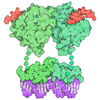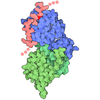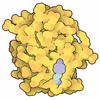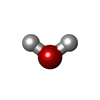Entry Database : PDB / ID : 6vc2Title LRH-1 bound to SS-RJW100 and a fragment of the Tif2 Coactivator Nuclear receptor coactivator 2 Nuclear receptor subfamily 5 group A member 2 Keywords / Function / homology Function Domain/homology Component
/ / / / / / / / / / / / / / / / / / / / / / / / / / / / / / / / / / / / / / / / / / / / / / / / / / / / / / / / / / / / / / / / / / / / / / / / / / / / / / / / / / / / / / / / / / / / / / / / / / / / / / / / / / / / / / / / / / / / / / / / / / / / / / / / / / / / / / / / / / / / / / / / / / / / / / / / / / / Biological species Homo sapiens (human)Method / / / Resolution : 1.697 Å Authors Mays, S.G. / Ortlund, E.A. Funding support Organization Grant number Country National Institutes of Health/National Institute of Diabetes and Digestive and Kidney Disease (NIH/NIDDK) R01-DK114213 National Institutes of Health/National Institute of Diabetes and Digestive and Kidney Disease (NIH/NIDDK) NIH F31-DK111171 National Institutes of Health/National Institute of Diabetes and Digestive and Kidney Disease (NIH/NIDDK) R01-DK095750 National Institutes of Health/National Institute of General Medical Sciences (NIH/NIGMS) T32-GM008602 National Science Foundation (NSF, United States)
Journal : Sci Rep / Year : 2020Title : Enantiomer-specific activities of an LRH-1 and SF-1 dual agonist.Authors : Mays, S.G. / Stec, J. / Liu, X. / D'Agostino, E.H. / Whitby, R.J. / Ortlund, E.A. History Deposition Dec 20, 2019 Deposition site / Processing site Revision 1.0 Dec 23, 2020 Provider / Type Revision 1.1 Dec 30, 2020 Group / Category / citation_authorItem _citation.country / _citation.journal_abbrev ... _citation.country / _citation.journal_abbrev / _citation.journal_id_CSD / _citation.journal_id_ISSN / _citation.journal_volume / _citation.page_first / _citation.page_last / _citation.pdbx_database_id_DOI / _citation.pdbx_database_id_PubMed / _citation.title / _citation.year Revision 1.2 Oct 11, 2023 Group / Database references / Refinement descriptionCategory chem_comp_atom / chem_comp_bond ... chem_comp_atom / chem_comp_bond / database_2 / pdbx_initial_refinement_model Item / _database_2.pdbx_database_accession
Show all Show less
 Open data
Open data Basic information
Basic information Components
Components Keywords
Keywords Function and homology information
Function and homology information Homo sapiens (human)
Homo sapiens (human) X-RAY DIFFRACTION /
X-RAY DIFFRACTION /  SYNCHROTRON /
SYNCHROTRON /  MOLECULAR REPLACEMENT / Resolution: 1.697 Å
MOLECULAR REPLACEMENT / Resolution: 1.697 Å  Authors
Authors United States, 5items
United States, 5items  Citation
Citation Journal: Sci Rep / Year: 2020
Journal: Sci Rep / Year: 2020 Structure visualization
Structure visualization Molmil
Molmil Jmol/JSmol
Jmol/JSmol Downloads & links
Downloads & links Download
Download 6vc2.cif.gz
6vc2.cif.gz PDBx/mmCIF format
PDBx/mmCIF format pdb6vc2.ent.gz
pdb6vc2.ent.gz PDB format
PDB format 6vc2.json.gz
6vc2.json.gz PDBx/mmJSON format
PDBx/mmJSON format Other downloads
Other downloads 6vc2_validation.pdf.gz
6vc2_validation.pdf.gz wwPDB validaton report
wwPDB validaton report 6vc2_full_validation.pdf.gz
6vc2_full_validation.pdf.gz 6vc2_validation.xml.gz
6vc2_validation.xml.gz 6vc2_validation.cif.gz
6vc2_validation.cif.gz https://data.pdbj.org/pub/pdb/validation_reports/vc/6vc2
https://data.pdbj.org/pub/pdb/validation_reports/vc/6vc2 ftp://data.pdbj.org/pub/pdb/validation_reports/vc/6vc2
ftp://data.pdbj.org/pub/pdb/validation_reports/vc/6vc2
 Links
Links Assembly
Assembly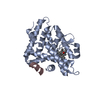
 Components
Components Homo sapiens (human) / Gene: NR5A2, B1F, CPF, FTF / Production host:
Homo sapiens (human) / Gene: NR5A2, B1F, CPF, FTF / Production host: 
 Homo sapiens (human) / References: UniProt: Q15596
Homo sapiens (human) / References: UniProt: Q15596 X-RAY DIFFRACTION / Number of used crystals: 1
X-RAY DIFFRACTION / Number of used crystals: 1  Sample preparation
Sample preparation SYNCHROTRON / Site:
SYNCHROTRON / Site:  APS
APS  / Beamline: 22-ID / Wavelength: 1 Å
/ Beamline: 22-ID / Wavelength: 1 Å Processing
Processing MOLECULAR REPLACEMENT
MOLECULAR REPLACEMENT Movie
Movie Controller
Controller




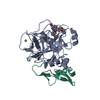
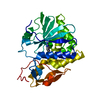

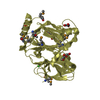
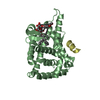


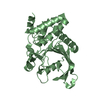
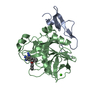
 PDBj
PDBj